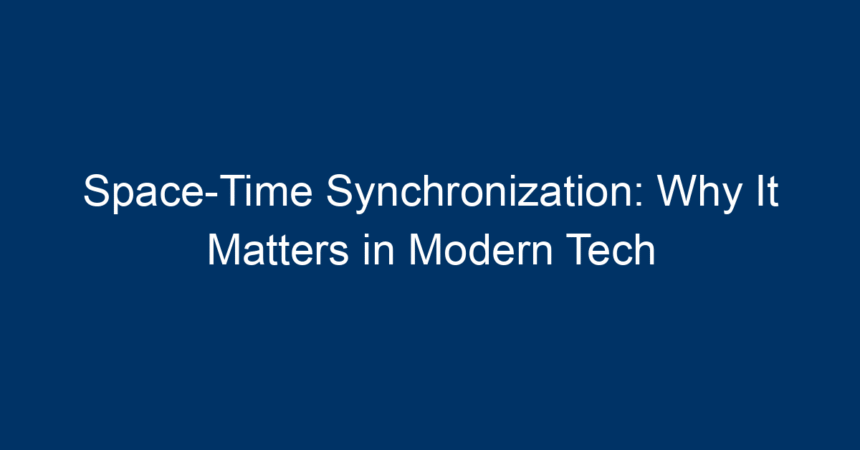In our fast-paced, tech-driven world, accurate timekeeping is more critical than ever. From coordinating global financial markets to enabling seamless communication between devices, the concept of space-time synchronization emerges as a fundamental pillar of modern technology. As we dive deeper into this intriguing subject, we’ll explore what space-time synchronization is, why it matters, and how it influences various sectors.
What is Space-Time Synchronization?
Space-time synchronization refers to the process of aligning clocks across different locations in both space and time. Imagine an orchestra: all musicians must play in harmony to create beautiful music. Similarly, clocks around the globe must synchronize to ensure smooth operations across technological platforms.
At its core, space-time synchronization ensures that all devices – whether satellites in orbit or smartphones in your pocket – operate on the same time scale. This process is achieved through various protocols and technologies that facilitate data transfer and timekeeping.
The Importance of Accurate Timekeeping
Maintaining an accurate measurement of time is not merely a matter of convenience; it’s essential for many industries and applications, including:
-
Telecommunications: Telecommunication networks rely on precise timing for data transmission and call routing. Any discrepancies can lead to delays, dropped calls, or even loss of data.
-
Finance: Stock markets operate across multiple time zones. Space-time synchronization is vital for ensuring that trade executions are recorded accurately, especially during high-frequency trading. Even a millisecond delay can result in significant financial losses.
-
GPS Technology: The Global Positioning System uses a network of satellites that send time-stamped signals. For GPS devices to determine accurate locations, synchronization between satellite clocks and receivers is paramount.
- Distributed Systems: In cloud computing and distributed systems, synchronized time ensures that transactions and operations occur in the correct order. Any loss of synchronization can result in data inconsistency and system failures.
How Space-Time Synchronization Works
To grasp how space-time synchronization functions, it’s useful to break it down into its fundamental components.
Network Time Protocol (NTP)
One of the most widely used methods to achieve space-time synchronization is the Network Time Protocol (NTP). NTP synchronizes clocks over a network, ensuring that devices stay in sync with standard time sources, such as atomic clocks or GPS signals. NTP is highly efficient and can sync devices with an accuracy of within milliseconds.
Precision Time Protocol (PTP)
While NTP is suitable for a general user environment, industries requiring more precision turn to the Precision Time Protocol (PTP). PTP can achieve an accuracy of sub-microsecond synchronization. This level of precision is crucial in sectors like telecommunications and broadcasting, where even tiny delays can disrupt processes.
Time Synchronization in Distributed Systems
In distributed systems, clock drift – where devices’ internal clocks gradually become out of sync – can pose significant challenges. Techniques such as Logical Clocks and Vector Clocks help manage order and consistency in transactions through various methods, providing high levels of reliability and performance.
Real-World Applications of Space-Time Synchronization
In Telecommunications
In the telecommunications industry, companies employ space-time synchronization to manage the flow of data. With the advent of 5G technology, timely data transmission is more critical than ever. A slight delay could hinder connectivity, leading to dropouts in video calls or buffering while streaming.
Financial Services
In financial markets, space-time synchronization is necessary for executing trades effectively. High-frequency trading platforms must maintain precise timing to outperform competitors. Accurate synchronization ensures that trades are executed at the correct prices, reducing risks involved in transactions.
Global Positioning Systems
GPS technology is an everyday application of space-time synchronization. Devices such as smartphones, vehicles, and drones rely on satellite signals that are time-stamped. This synchronization between satellite and receiver enables accurate location tracking and navigation.
Internet of Things (IoT)
As IoT devices proliferate, the need for effective space-time synchronization grows. Whether it’s smart home devices or industrial automation systems, synchronized timing enables these devices to communicate effectively and act according to commands, ensuring optimal functionality.
Challenges in Space-Time Synchronization
Despite the advanced technologies employed to ensure synchronization, challenges still persist.
Delays and Jitter
Network delays can disrupt synchronization. Variability in network performance, known as jitter, complicates timekeeping. This inconsistency can lead to problems in data integrity, particularly in real-time applications.
Security Risks
Synchronizing time across systems opens potential security vulnerabilities. Hackers can exploit synchronization protocols to inject false time information, leading to unauthorized access and data breaches.
Environmental Factors
In environments where devices operate under various conditions, synchronization can be challenging. Factors such as temperature variations can affect clock performance, leading to drift.
Future Trends in Space-Time Synchronization
As technology continues to evolve, so too will the methods employed for space-time synchronization. Emerging trends include:
-
Blockchain Technology: Utilizing blockchain for decentralized timekeeping presents unique advantages, including enhanced security and reliability. Blockchain’s immutable ledger can help maintain time records across distributed systems.
-
Quantum Timekeeping: The exploration of quantum mechanics in timekeeping could revolutionize synchronization accuracy. Quantum clocks might offer unprecedented precision, which could transform many sectors, including telecommunications and computing.
- Artificial Intelligence: Integrating AI with time synchronization protocols may improve the efficiency and reliability of systems. AI can analyze data flow and adjust synchronization methods dynamically, mitigating issues related to delays or drift.
Conclusion: The Need for Effective Space-Time Synchronization
As we navigate an increasingly interconnected world, the importance of space-time synchronization cannot be overstated. In sectors ranging from telecommunications to finance, accurate timekeeping ensures that operations run smoothly and efficiently.
Investing in robust space-time synchronization technologies is not just a luxury; it is rapidly becoming a necessity. Organizations must prioritize synchronization to maintain a competitive edge and ensure operational integrity. As we look ahead, embracing new innovations in timekeeping will be critical to thriving in an ever-evolving digital landscape.
Actionable Insights
-
Evaluate Current Systems: Assess your organization’s current synchronization methods. Identify any potential vulnerabilities and consider upgrading to more accurate protocols such as PTP.
-
Invest in Training: Ensure that your team understands the importance of synchronization and how to manage potential issues effectively.
- Stay Informed: Keep abreast of emerging technologies in timekeeping, such as quantum clocks and blockchain, which could enhance your synchronization strategy.
By prioritizing space-time synchronization, you can position your organization for success in a rapidly advancing technological ecosystem.




